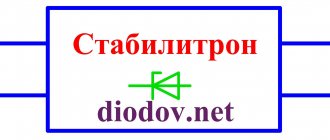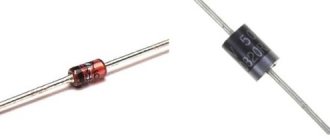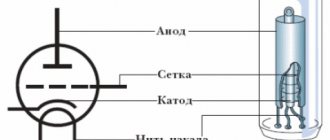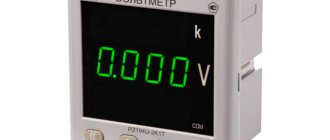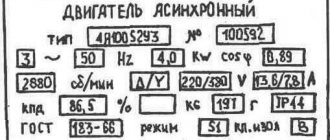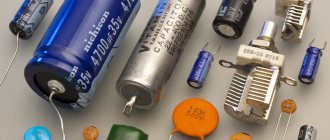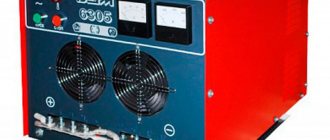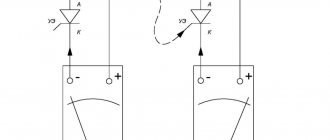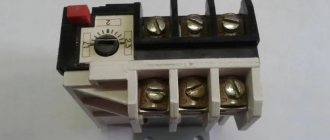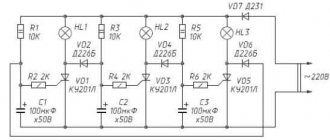Zener diode refers to one of the used radio-electronic elements. Each more or less high-quality power supply contains a voltage stabilization unit, which can change when the load resistance changes or when the input voltage deviates from the nominal value.
Voltage stabilization is performed mainly to ensure normal operation of the remaining radio elements of the device, for example microcircuits, transistors, microcontrollers, etc.
Zener diodes are widely used in low-power power supplies or in individual units, the power of which rarely exceeds tens of watts.
The main advantage of zener diodes is their low cost and size, so they still cannot be replaced by integrated voltage stabilizers such as LM7805 or 78L05, etc.
A zener diode is very similar to a diode because its semiconductor crystal is housed in a similar package.
The conventional graphic designation of a zener diode on electrical circuit drawings is also similar to the designation of a diode, only on the cathode side a short horizontal line is added, directed towards the anode.
What is a zener diode
Almost no voltage stabilizer can do without this semiconductor.
In appearance it can easily be confused with a diode. You can find out which element stabilizes the potential difference by marking. A Zener diode (zener diode) has high resistance until breakdown occurs. The applied reverse bias causes a breakdown of the junction, and the current begins to rapidly increase, and the resistance decreases in the range from hundreds of Ohms to its fractional values. This mode of operation makes it possible to maintain a constant voltage value on the element with a certain accuracy. The main task of a semiconductor is to stabilize the voltage. They produce parts in series that are designed to maintain 1.8-400 V. The radio component is included in the circuit in parallel with the load.
Conventional graphic designation of an element
Attention! A two-terminal network has conclusions: a cathode and an anode. If we consider the region of the pn junction, then the terminal connected to the p-region is the anode, and to the n-region is the cathode.
Semiconductor elements that are composed of two counter-directed zener diodes are called double-sided (two-node).
Double-sided zener diode
The classification of these two-terminal networks according to their functional purpose is as follows:
- parts for general use (discrete), power: 0-0.3; 0.3-5; 5-10 W and above;
- precision elements with a complex microcircuit in their structure (hidden structure);
- limiting zener diodes designed for interference suppressors.
The latter are designed for short-term transmission of pulsed current up to hundreds of amperes. Long-term operation with high currents causes overheating of the part and thermal breakdown.
Attention! A silicon diode (zener diode) connected to the circuit in the reverse direction has three types of breakdown: tunnel, avalanche, and caused by thermal instability. Their design implies the occurrence of the first two breakdowns before thermal destruction of the junction occurs.
Switching circuit and current-voltage characteristic (volt-ampere characteristic) Zener diode
Tunnel and avalanche breakdown
The breakdown of the pn junction, at which zener diodes operate, can be avalanche or tunnel. They are electrical and reversible. That is, when the reverse bias is turned off, the physicochemical properties of the semiconductors are restored, and the diode continues to perform its functions. However, in the case of zener diodes, the conditions for the occurrence of breakdown are created and maintained artificially. Avalanche and tunnel breakdown are based on quantum effects of the same name, observed in the crystal structure of a semiconductor when an electric field is excited. With different natures and mechanisms of these processes, their consequences are the same - electrons acquire energy sufficient to pass through the pn junction. A breakdown occurs and reverse current begins to flow through the diode. It is in this mode that the zener diode operates. However, there is a difference between radio components that use different effects. Zener diodes operating during avalanche breakdown operate with potential differences of over 7 Volts. In elements designed for a stabilization voltage of 3-7 Volts, a tunnel breakdown is provoked. To stabilize lower potential differences, stabistors are used, which we will discuss below.
Marking of zener diodes
In order to find out the stabilization voltage of the Soviet zener diode, we need a reference book. For example, in the photo below there is a Soviet zener diode D814V:
We look for parameters for it in online directories on the Internet. As you can see, its stabilization voltage at room temperature is approximately 10 Volts.
Foreign zener diodes are marked more easily. If you look closely, you can see a simple inscription:
5V1 - this means the stabilization voltage of this zener diode is 5.1 Volts. Much easier, right?
The cathode of foreign zener diodes is marked mainly with a black stripe
Zener diode or Zener diode
The simplest voltage stabilizer in electronics is a zener diode . It is sometimes also called a Zener diode . In the diagrams, zener diodes are designated something like this:
The terminal with the “cap” is called the same as the diode - cathode , and the other terminal is anode .
Zener diodes look the same as diodes. In the photo below, on the left is a popular type of modern zener diode, and on the right is one of the samples from the Soviet Union
If you take a closer look at the Soviet zener diode, you can see this schematic designation on it itself, indicating where its cathode is and where its anode is.
Main characteristics of a zener diode
To select a Zener diode for existing purposes, you need to know several important parameters. These characteristics will determine the suitability of the selected device for solving the assigned tasks.
Rated stabilization voltage
The first zener parameter that you need to pay attention to when choosing is the stabilization voltage, determined by the point at which the avalanche breakdown begins. This is where the choice of device to use in the circuit begins. For different instances of ordinary zener diodes, even of the same type, the voltage has a spread of around several percent; for precision ones, the difference is lower. If the nominal voltage is unknown, it can be determined by constructing a simple circuit. You should prepare:
- ballast resistor 1…3 kOhm;
- adjustable voltage source;
- voltmeter (you can use a tester).
It is necessary to increase the voltage of the power source from zero, monitoring the increase in voltage on the zener diode using a voltmeter. At some point it will stop, despite further increasing the input voltage. This is the actual stabilization voltage. If there is no regulated source, you can use a power supply with a constant output voltage obviously higher than Ustabilization. The measurement scheme and principle remain the same. But there is a risk of the semiconductor device failing due to exceeding the operating current.
Zener diodes are used to work with voltages from 2...3 V to 200 V. To generate a stable voltage below this range, other devices are used - stabistors, operating in the direct section of the current-voltage characteristic.
Operating current range
The current at which the zener diodes perform their function is limited above and below. From below it is limited by the beginning of the linear section of the reverse branch of the current-voltage characteristic. At lower currents, the characteristic does not provide a constant voltage mode.
The upper value is limited by the maximum dissipation power that the semiconductor device is capable of and depends on its design. Zener diodes in a metal case are designed for higher current, but do not forget about the use of radiators. Without them, the maximum permissible power dissipation will be significantly less.
Differential resistance
Another parameter that determines the operation of the zener diode is the differential resistance Rst. It is defined as the ratio of the voltage change ΔU to the current change ΔI that caused it. This quantity has the dimension of resistance and is measured in ohms. Graphically, this is the tangent of the angle of inclination of the working section of the characteristic. Obviously, the lower the resistance, the better the quality of stabilization. For an ideal (which does not exist in practice) zener diode Rst is equal to zero - any increase in current will not cause any change in voltage, and the section of the current-voltage characteristic will be parallel to the ordinate axis.
Types of diodes and their purpose
In short, a diode is a semiconductor component in an electronic circuit designed to carry current in one direction. In other words, the device passes current in one direction, blocking its flow in the opposite direction, forming a kind of electric valve.
On circuit diagrams, the diode is indicated by a pointer arrow, at the end of which there is a line indicating locking. The arrow indicates the direction of current flow.
It must be remembered that in theoretical physics, current is formed by positively charged particles. Therefore, to open a pn junction, a positive potential is applied to the beginning of the arrow, and a negative potential to its end. Under such conditions, direct current will flow through the device.
Let's consider the most common types of diodes, given that only a few are of interest in terms of testing, namely:
- conventional diodes based on a pn junction;
- with a Schottky barrier, more often called simply Schottky diodes;
- Zener diode, which serves to stabilize the potential and other types.
There are many more types of diodes - varicaps, LEDs or photodiodes, for example. But due to the similarity of performance testing or low prevalence, these devices are not considered here.
Types of Zener diodes
There are three main types of zener diodes:
- Precision zener diodes - they are characterized by increased voltage stability. Example: 2S191 or KS211.
- Bilateral – limit and stabilize bipolar voltage. Example: 2С170А or 2С182А.
- High-speed zener diode - reduced barrier capacitance and low transient work - this makes it possible to work in the region of short-term voltage pulses. These are the following zener diodes: 2S175E; KS182E; 2S211E.
We recommend reading: Stepper motor control
Power distribution - these are high-power and low-power zener diodes.
Marking of SMD diodes, reference codes
Existing SMD diodes or other types of parts may be called chips, or SMD components. In Russian schematics and industry they are often called TMP - surface mounting technology. The number of parts is very large, so the designations are collected in electronic databases and can be saved to a computer for quickly identifying a diode or other component. The volumes of the databases are different, but they all include several thousand designations.
It is useful for any practitioner to have such a reference book so as not to waste time recognizing markings, searching for analogues or other use cases. Sometimes it becomes possible to replace conventional diodes or other parts with chips, which gives a considerable gain:
- size decreases;
- parasitic effects manifested in capacitance and inductance are reduced;
- work with low-level signals is improved.
At first glance, it is not easy to understand the variety of chips, however, the compilers of reference books understand this and combine all the data into groups. Diodes, capacitors, resistors and other types are considered separately. This makes it somewhat easier to navigate through huge amounts of data.
Types of 12 volt stabilizers
Depending on the design and method of maintaining a 12-volt voltage, there are two types of stabilizers:
- Pulse stabilizers, consisting of an integrator (battery, high-capacity electrolytic capacitor) and a switch (transistor). Maintaining the voltage in a given range of values occurs due to the cyclic process of accumulation and rapid release of charge by the integrator when the key is open. According to their design features and control method, such stabilizers are divided into key devices with a Schmitt trigger, equalizers with pulse width and pulse frequency modulation.
- Linear - voltage-stabilizing devices in which zener diodes or special microcircuits connected in series are used as a regulating device.
Pulse
Linear
The most common and popular among car enthusiasts are linear devices, characterized by ease of self-assembly, reliability and durability. The pulse type is used much less frequently due to the high cost of parts and the difficulties of independent production and repair.
Classic model
Classic stabilizers are a large class of devices assembled based on semiconductor parts such as bipolar transistors and zener diodes. Among them, the main function of maintaining the voltage at 12 V is performed by zener diodes - a type of diodes connected in reverse polarity (the plus of the power supply is connected to the cathode of such a semiconductor device, and the minus to the anode), operating in breakdown mode. The essence of how these semiconductor parts work is as follows:
- When the voltage of the power source connected to the zener diode is less than 12 V, it is in the closed position and does not participate in adjusting this characteristic of the electric current.
- When the threshold of 12 Volts is exceeded, the zener diode “opens” and maintains this value in the range specified by its characteristics.
If the voltage supplied to the zener diode exceeds that stated as the maximum by the manufacturer, the device very quickly fails due to the effect of thermal runaway.
In order for any zener diode model to serve as long as possible, it is recommended to specify the voltage range and current in which it should be operated according to its specifications. Depending on the connection, there are two versions of the classic stabilizer: linear - the adjusting elements are connected in series with the load; parallel – voltage stabilizing devices are located parallel to the powered devices.
Integral stabilizer
The devices are assembled using small-sized microcircuits capable of operating at an input voltage of up to 26-30 V, delivering a constant 12-volt current of up to 1 Ampere. A special feature of these radio components is the presence of 3 legs - “input”, “output” and “adjustment”. The latter is used to connect an adjustment resistor, which is used to adjust the microcircuit and prevent it from overloading.
More convenient and reliable equalizers assembled on the basis of stabilizing microcircuits are gradually replacing analogues assembled on discrete elements.
How to distinguish a stabilization diode from a conventional semiconductor
Very often people wonder how they can distinguish a zener diode from a standard semiconductor, because, as we found out earlier, both of these elements have almost identical symbols on the electrical circuit and can perform similar functions. The easiest way to distinguish a stabilization semiconductor from a regular one is to use a multimeter attachment circuit. With its help, you can not only distinguish both elements from each other, but also identify the stabilization voltage, which is characteristic of a given SMD (if it, of course, does not exceed 35V). The multimeter attachment circuit is a DC-DC converter, in which there is galvanic isolation between the input and output. This diagram looks like this:
Multimeter attachment circuit
In it, a generator with pulse-width modulation is implemented on a special microcircuit MC34063, and to create galvanic isolation between the measuring part of the circuit and the power source, the control voltage should be removed from the primary winding of the transformer. For this purpose there is a rectifier on VD2. In this case, the value for the output voltage or stabilization current is set by selecting resistor R3. A voltage of approximately 40V is released at capacitor C4. In this case, the tested SMD VDX and the stabilizer for current A2 will form a parametric stabilizer. The multimeter, which is connected to terminals X1 and X2, will measure the voltage at this zener diode. When connecting the cathode to the “-” and the anode to the “+” of the diode, as well as to the asymmetrical SMD of the multimeter, the latter will show a slight voltage. If you connect in reverse polarity (as in the diagram), then in a situation with a conventional semiconductor, the device will register a voltage of about 40V.
Note! For symmetrical SMD, the breakdown voltage will appear in the presence of any connection polarity.
Here the T1 transformer will be wound on a torus-shaped ferrite core with an outer diameter of 23 mm. Such winding 1 will contain 20 turns, and the second winding will contain 35 turns of PEV 0.43 wire. In this case, it is important to lay the turn to the turn when winding. It should be remembered that the primary winding goes on one part of the ring, and the second on the other. When setting up the device, connect a resistor instead of smd VDX. This resistor should have a value of 10 kOhm. And resistance R3 needs to be selected in order to achieve a voltage of 40V on capacitor C4. This is how you can find out whether you have a zener diode or a regular diode.
Features of using zener diodes
To use zener diodes, especially from Russian manufacturers, it is not advisable to operate outside the breakdown zone, which is a consequence of an increase in leakage current over time. For example, it is not recommended to apply a voltage different from the calculated value to a zener diode designed for U15 V; at least it is necessary to monitor the minimum stabilization current.
During an unsuccessful voltage dispersion, when it is selected to the limit value, the device may overheat and a breakdown mode may occur.
It is undesirable to connect zener diodes to the network as a fuse; the consequences for the zener diode will be disastrous; if the current value is exceeded, they will fail. For protection, it is best to use, in some cases, specialized zener diodes (suppressors) of the ZY5.6 brand. Installing a zener diode (Zener diode) in the low-voltage power supply circuit is extremely undesirable due to the fact that tunnel breakdown at U has a negative temperature coefficient.
Write comments, additions to the article, maybe I missed something. Take a look at the site map, I will be glad if you find anything else useful on my site.
Types of diodes and their purpose
In short, a diode is a semiconductor component in an electronic circuit designed to carry current in one direction. In other words, the device passes current in one direction, blocking its flow in the opposite direction, forming a kind of electric valve.
On circuit diagrams, the diode is indicated by a pointer arrow, at the end of which there is a line indicating locking. The arrow indicates the direction of current flow. It must be remembered that in theoretical physics, current is formed by positively charged particles. Therefore, to open a pn junction, a positive potential is applied to the beginning of the arrow, and a negative potential to its end. Under such conditions, direct current will flow through the device.
Let's consider the most common types of diodes, given that only a few are of interest in terms of testing, namely:
- conventional diodes based on a pn junction;
- with a Schottky barrier, more often called simply Schottky diodes;
- Zener diode, which serves to stabilize the potential and other types.
There are many more types of diodes - varicaps, LEDs or photodiodes, for example. But due to the similarity of performance testing or low prevalence, these devices are not considered here.
How to check zener diode
How to check the zener diode? Yes, just like a diode! You can see how to check the diode in this article. Let's check our zener diode. We put the multimeter on the continuity test and attach the red probe to the anode, and the black probe to the cathode. The multimeter should show the voltage drop of the forward PN junction.
We swap the probes and see one. This means that our zener diode is in full combat readiness.
Well, it's time for experiments. In the circuits, a zener diode is connected in series with a resistor:
where Uin – input voltage, Uout.st. – output stabilized voltage
If we look closely at the diagram, we get nothing more than a voltage divider. Everything here is elementary and simple:
Uin=Uout.stab +Uresistor
Or in words: the input voltage is equal to the sum of the voltages on the zener diode and the resistor.
This circuit is called a parametric stabilizer on one zener diode. The calculation of this stabilizer is beyond the scope of this article, but for those interested, Google it.
So, let's put together the circuit. We took a resistor with a nominal value of 1.5 Kilohms and a zener diode with a stabilization voltage of 5.1 Volts. On the left we connect the Power Supply, and on the right we measure the resulting voltage with a multimeter:
Now we carefully monitor the readings of the multimeter and power supply:
So, while everything is clear, let’s add more tension... Oops! Our input voltage is 5.5 Volts, and our output voltage is 5.13 Volts! Since the stabilization voltage of the zener diode is 5.1 Volts, as we can see, it stabilizes perfectly.
Let's add some more volts. The input voltage is 9 Volts, and the zener diode is 5.17 Volts! Amazing!
We also add... The input voltage is 20 Volts, and the output, as if nothing had happened, is 5.2 Volts! 0.1 Volt is a very small error, it can even be neglected in some cases.
Basic circuit of a parallel stabilizer
The simplest parallel stabilizer consists of a ballast resistor connected in series between the power source and the load, and a zener diode that shunts the load to a common wire (“to ground”). It can be considered as a voltage divider, in which a zener diode is used as the lower arm. The difference between the supply voltage and the breakdown voltage of the zener diode drops across the ballast resistor, and the supply current flowing through it branches into the load current and the zener diode current. Stabilizers of this kind are called parametric: they stabilize the voltage due to the nonlinearity of the current-voltage characteristic of the zener diode, and do not use feedback circuits.
We recommend reading: Types of batteries: detailed classification of batteries by size, composition and other parameters
The calculation of a parametric stabilizer on semiconductor zener diodes is similar to the calculation of a stabilizer on gas-filled devices, with one significant difference: gas-filled zener diodes are characterized by threshold voltage hysteresis. When there is a capacitive load, the gas-filled zener diode is self-excited, so the designs of such stabilizers usually do not contain capacitive filters, and the designer does not need to take into account transient processes in these filters. In stabilizers based on semiconductor zener diodes, there is no hysteresis; filter capacitors are connected directly to the terminals of the zener diode and the load - as a result, the designer must take into account the surge current of the charge (discharge) of these capacitors when turning the power on (off). The worst cases in which the stabilizer elements are likely to fail or stabilization to fail are:
- Supplying the maximum possible supply voltage to the input of the stabilizer in the event of a short circuit of the stabilizer output to the common wire - for example, while charging a discharged capacitor connected directly to the output of the stabilizer, or in the event of a catastrophic failure of the zener diode. The permissible power dissipation of the ballast resistor must be sufficient to withstand such a short circuit. Otherwise, the ballast resistor is likely to be destroyed.
- Supplying the maximum possible supply voltage to the stabilizer input when the load is disconnected from the stabilizer output. The permissible current of the zener diode must exceed the calculated current through the ballast resistor, determined by Ohm's law. Otherwise, when the zener diode crystal is heated above +175 °C, the zener diode is destroyed. Compliance with the safety data sheet is just as important for zener diodes as for transistors.
- The load selects the maximum possible current when the minimum possible supply voltage is supplied to the stabilizer input. The resistance of the ballast resistor must be small enough so that, even under these conditions, the current through the resistor exceeds the load current by an amount equal to the minimum permissible current of the zener diode. Otherwise, the zener diode current is interrupted and stabilization stops.
In practice, it often turns out that it is impossible to meet all three conditions, both for reasons of the cost of components and because of the limited range of operating currents of the zener diode. First of all, you can sacrifice the condition of short circuit protection, entrusting it to fuses or thyristor protection circuits, or rely on the internal resistance of the power supply, which will not allow it to produce both the maximum voltage and maximum current at the same time.
Series and parallel connection
In the documentation for foreign-made zener diodes, the possibility of their serial or parallel connection is usually not considered. In the documentation for Soviet zener diodes there are two formulations:
- for low and medium power devices, “serial or parallel connection of any number of zener diodes” [of the same series] is allowed;
- for medium and high power devices, “a series connection of any number of zener diodes [of the same series] is allowed.” Parallel connection is permitted provided that the total power dissipation on all parallel-connected zener diodes does not exceed the maximum permissible power for one zener diode."
Series connection of zener diodes of different series is possible provided that the operating currents of the series chain fall within the certified stabilization current ranges of each series used. There is no need to shunt zener diodes with high-resistance equalizing resistors, as is done in rectifier columns. “Any number” of zener diodes connected in series is possible, but in practice is limited by technical conditions for the electrical safety of high-voltage devices. Subject to these conditions, when selecting zener diodes according to TKN and their thermostatting, it is possible to construct precision high-voltage voltage standards. For example, in the 1990s, the zener diode standard of 1 million V, built by Russia at the request of the Canadian energy institute IREQ, had the best stability indicators in the world. The main error of this installation did not exceed 20 ppm, and the temperature instability did not exceed 2.5 ppm over the entire operating temperature range.
Composite Zener diode
If the circuit requires removing higher currents and powers from the zener diode than is permissible according to the technical conditions, then a DC buffer amplifier is connected between the zener diode and the load. In the “composite zener diode” circuit, the collector junction of the single current-amplifying transistor is connected in parallel with the zener diode, and the emitter junction is in series with the zener diode. The resistance that sets the bias of the transistor is selected so that the transistor smoothly turns on at a zener diode current approximately equal to its rated stabilization current. For example, with Ist.nom.=5 mA and Ube.min. =500 mV resistance R=500 mV/5 mA=100 Ohm, and the voltage on the “composite zener diode” is equal to the sum of Ust.nom. and Ube.min.. At high currents, the transistor opens and shunts the zener diode, and the zener diode current increases slightly - by an amount equal to the base current of the transistor, therefore, to a first approximation, the differential resistance of the circuit decreases by a factor (is the current gain of the transistor). The TKN of the circuit is equal to the algebraic sum of the TKN of the zener diode at Ist.nom. and TKN of a forward biased diode (approximately -2 mV/°C), and its area of safe operation in practice is limited by the OBR of the transistor used.
SMD marking of electrical elements
The principle of marking is the encrypted transmission of information about the dimensions and electrical parameters of the chip. There is a conditional division according to the number of pins and the size of the element housing:
| Number of pins | Case marking in ascending order of size | Short description |
| Two-pin | SOD (for example, SOD128, SOD323, etc.) or WLCSP2 | Passive chips of cylindrical or square shape, tantalum capacitors, diodes |
| Three-pin | DPAK, D2PAK, D3PAK | The author of this case is Motorola. All elements have the same shape, but different sizes. Used for semiconductor elements that produce thermal energy |
| Four-pin and more | WLCSP(N) (N indicates the number of pins), SOT, SOIC, SSOP, CLCC, LQFP, DFN, DIP / DIL, Flat Pack, TSOP, ZIP | The contacts of these chips are located on two opposite sides of the case |
| Elements with more than four contacts | LCC, PLCC, QFN, QFP, QUIP | Pins are located on all four sides of the housing |
| The pins are arranged in a lattice pattern | BGA, uBGA | Microcircuits intended for soldering using special paste |
| Leadless elements | μBGA, LFBGA | Equipped with contact strips or solder drops only |
Chip capacitors
There are two main types of capacitors - electrolytic (the body is cylindrical) and ceramic or tantalum (the body is shaped like a parallelepiped). Electrolyte markings always contain capacitance and voltage values, but ceramic samples do not. The minus (cathode) of the electrolytes is indicated by a strip located on the upper side of the housing.
Marking of SMD resistors
The marking is represented by several characters - numbers and letters. The first two digits indicate the denomination, and the third (and fourth) indicate the order, or the number of zeros. For example, the number 322 means 3200 ohms or 3.2 kohms. Sometimes the R separator is used, acting as a comma. So, the designation 3R2 means 3.2 kOhm. Or 0R32 - 0.32 kOhm.
There are special resistors that act as fuses or jumpers. They have a zero resistance rating.
The dimensions of SMD devices are standardized and associated with markings. Thus, chips of diodes, resistors or capacitors of size 0805 have parameters of 0.6 × 0.8 × 0.23 inches (length-width-height).
SMD inductance
The shape and dimensions of the housings of the chokes and inductors have the same values as those of resistors or capacitors. The designation consists of 4 digits. The first two are the length, the others are the width of the chip, expressed in tenths of an inch. For example, the throttle marking 0805 means that its length is 0.08 and its width is 0.05 inches.
SMD diodes and transistors
Diode chips can be made in the form of a barrel or parallelepiped (briquette). All sizes fully correspond to the parameters of the resistors, which simplifies the development of printed circuit boards. Given the specific operation of diodes, for which polarity must be observed, there is a strip on or near the negative terminal. It designates the cathode, which helps avoid installation errors.
On the surface of the chip there can only be a code that does not provide complete information about the parameters of the part. Therefore, there are special information arrays - datasheets, which contain information about all the parameters and capabilities of the elements. If you need complete data on the properties that transistors have, the datasheet makes it possible to obtain detailed information.
Two types of housings are used:
- SOT;
- DPAK.
In addition to transistors, diode assemblies used in rectifiers and drivers can be produced in this format.
Basic parameters of zener diodes
In order to select the right zener diode, you need to understand the markings of semiconductor devices. Previously, all types of diodes, including zener diodes, were designated by the letter “D” and a number indicating what kind of device it was. Here is an example of the very popular D814 zener diode (A, B, C, D). The letter showed the stabilization voltage.
| D814B | 2С147А |
|
|
Nearby are the passport data of a modern zener diode (2C147A), which was used in stabilizers to power circuits based on the popular series of K155 and K133 microcircuits made using TTL technology and having a supply voltage of 5V.
To understand the markings and basic parameters of modern domestic semiconductor devices, you need to know a little about the symbols. They look like this: number 1 or letter G - germanium, number 2 or letter K - silicon, number 3 or letter A - gallium arsenide. This is the first sign. D – diode, T – transistor, S – zener diode, L – LED. This is the second sign. The third character is a group of numbers indicating the scope of application of the device. Hence: GT 313 (1T 313) - high-frequency germanium transistor, 2S147 - silicon zener diode with a nominal stabilization voltage of 4.7 volts, AL307 - gallium arsenide LED.
Here is a diagram of a simple but reliable voltage stabilizer.
We recommend reading: Pinout of different types of USB connectors: pinout of micro and mini usb, pinout features
A voltage of 12–15 volts is supplied between the collector of the powerful transistor and the housing from the rectifier. We remove 9V stabilized voltage from the emitter of the transistor, since we use the reliable D814B element as the zener diode VD1 (see table). Resistor R1 is 1 kOhm, transistor KT819 provides current up to 10 amperes.
The transistor must be placed on the heat sink. The only drawback of this circuit is the inability to adjust the output voltage. In more complex circuits, of course, there is a tuning resistor. All laboratory and home amateur radio power sources have the ability to adjust the output voltage from 0 to 20 - 25 volts.
Details about the color coding of the stabilizing diode
Zener diode marking
Any diode (zener diode, etc.) contains a special marking on its case, which reflects what material was used to manufacture each specific semiconductor. Such marking may look like this:
- letter or number;
- letter.
In addition, the marking reflects the electrical properties and purpose of the device. Usually a number is responsible for this. The letter, in turn, reflects the corresponding type of device. In addition, the marking contains the date of manufacture and the symbol of the product. Integral type SMDs often contain full markings. In such a situation, there is a conditional code on the product body that indicates the type of microcircuit. An example of decoding the code markings for microcircuits applied to the housing is shown in the figure:
Example of microcircuit marking
In addition, there is also color coding. It exists in several versions, but the most commonly used is the Japanese marking (JIS-C-7012). The color coding is shown in the following table.
The principle of operation of a zener diode
First of all, we should not forget that the zener diode only works in DC circuits. The voltage is applied to it in reverse polarity, that is, a minus “-” will be applied to the anode of the zener diode. With this connection, reverse current flows through it (I return) from the rectifier. The voltage from the rectifier output can change, the reverse current will also change, but the voltage at the zener diode and at the load will remain unchanged, that is, stable. The following figure shows the current-voltage characteristic of a zener diode.
The zener diode operates on the reverse branch of the current-voltage characteristic (volt-ampere characteristic), as shown in the figure. Its main parameters include U st. (stabilization voltage) and I st. (stabilization current). These data are indicated in the passport for a specific type of zener diode. Moreover, the value of the maximum and minimum current is taken into account only when calculating stabilizers with a predicted large voltage change.
Stabilization voltage
The most important parameter of a zener diode is, of course, the stabilization voltage. What is this parameter?
Let's take a glass and fill it with water...
No matter how much water we pour into a glass, its excess will pour out of the glass. I think this is understandable to a preschooler.
Now by analogy with electronics. The glass is a zener diode. The water level in a glass full to the brim is the stabilization voltage of the zener diode. Imagine a large jug of water next to a glass. We will just fill our glass with water from the jug, but we don’t dare touch the jug. There is only one option - pour water from a jug by punching a hole in the jug itself. If the jug were smaller in height than the glass, then we would not be able to pour water into the glass. To explain it in electronics terms, the jug has a “voltage” greater than the “voltage” of the glass.
So, dear readers, the whole principle of operation of a zener diode is contained in the glass. No matter what stream we pour on it (well, of course, within reason, otherwise the glass will carry away and break), the glass will always be full. But it is necessary to pour from above. This means the voltage that we apply to the zener diode must be higher than the stabilization voltage of the zener diode.
Zener diode connection circuits
The main circuit for connecting a zener diode is in series with a resistor, which sets the current through the semiconductor device and takes on the excess voltage. Two elements make up a common divisor. When the input voltage changes, the drop across the zener diode remains constant, but across the resistor changes.
Such a circuit can be used independently and is called a parametric stabilizer. It keeps the load voltage constant despite fluctuations in input voltage or current consumption (within certain limits). A similar block is also used as an auxiliary circuit where a reference voltage source is needed.
Such a connection is also used to protect sensitive equipment (sensors, etc.) from abnormal occurrence of high voltage in the power or measurement line (constant or random pulses). Everything above the stabilization voltage of the semiconductor device is “cut off”. This scheme is called the “Zener barrier”.
Previously, the property of a zener diode to “cut off” voltage peaks was widely used in pulse shaper circuits. In alternating current circuits, two-anode devices were used.
But with the development of transistor technology and the advent of integrated circuits, this principle began to be rarely used.
If you don’t have a zener diode for the required voltage at hand, it can be made up of two. The total stabilization voltage will be equal to the sum of the two voltages.
Important! You cannot connect zener diodes in parallel to increase the operating current! A scatter in the current-voltage characteristics will lead to one zener diode entering the thermal breakdown zone, and then the second will fail due to excess load current.
Although technical documentation from the times of the USSR allows the inclusion of parallel zeners in parallel, but with the caveat that the devices must be of the same type and the total actual power dissipation during operation should not exceed that permissible for a single zener diode. That is, an increase in operating current under this condition cannot be achieved.
To increase the permissible load current, another circuit is used. The parametric stabilizer is supplemented with a transistor, and an emitter follower is obtained with a load in the emitter circuit and a stable voltage at the base of the transistor.
In this case, the output voltage of the stabilizer will be less than Ustabilization by the amount of the voltage drop across the emitter junction - for a silicon transistor, about 0.6 V. To compensate for this decrease, you can connect a diode in series with the zener diode in the forward direction.
In this way (by turning on one or more diodes) you can adjust the output voltage of the stabilizer upward within small limits. If you need to radically increase Uout, it is better to connect another zener diode in series.
The scope of application of the zener diode in electronic circuits is extensive. With a conscious approach to selection, this semiconductor device will help solve many problems assigned to the developer.
Back-to-back, parallel, series connection of zener diodes
To increase the stabilization voltage, two or more zener diodes can be connected in series. For example, you need to get 17 V at the load, then, if the required rating is not available, support diodes of 5.1 V and 12 V are used.
Parallel connection is used to increase current and power.
Zener diodes are also used to stabilize alternating voltage. In this case, they are connected in series and counter.
During one half-cycle of alternating voltage, one zener diode operates, and the second operates like a regular diode. In the second half-cycle, semiconductor elements perform opposite functions. However, in this case, the shape of the output voltage will be different from the input voltage and will look like a trapezoid. Due to the fact that the reference diode will cut off a voltage exceeding the stabilization level, the tops of the sine wave will be cut off.
How to make a 12V stabilizer
Simple, but at the same time quite effective, reliable and durable stabilizing devices can be made independently, using simple zener diodes and special small microcircuits such as LM317, LD1084, L7812, KREN (KR142EN8B).
Stabilizer on LM317
The assembly process of such a voltage-stabilizing device consists of the following steps:
- A 130-ohm resistance is soldered to the middle output contact of the microcircuit.
- A conductor is soldered to the input right contact, supplying an unstabilized voltage from the power source.
- The left adjustment contact is soldered to the second leg of the resistor installed at the output of the microcircuit.
The soldering process of such a stabilizer takes no more than 10 minutes and, taking into account the inexpensive microcircuit, does not require large investments. Using a similar device, LED lights and strips are powered.
Chip LD1084
The assembly of a device for stabilizing the voltage of an automobile on-board network using the LD1084 microcircuit is carried out as follows:
- A conductor with positive voltage from the diode bridge is soldered to the input contact of the microcircuit.
- The emitter of a bipolar transistor is soldered to the adjustment contact, the base of which, through two resistors with a nominal value of 1 kOhm, supplies the current of the low and high beam headlights.
- Two resistors are soldered to the output contact (one is a regular 120 Ohm, and the second is a trimmer, 4.7 kOhm) and a 10 µF electrolytic capacitor
To smooth out the current ripple, another electrolytic capacitor with a capacity of 10 μF is installed after the diode bridge.
Test method
Checking diodes with a multimeter consists of determining the functionality of their pn junction. In general, there are only two malfunctions in radio electronics. The first is a circuit break (burnout) when current does not flow in either direction. The second is caused by a short circuit (breakdown) of the electrodes, which turns the component into a piece of ordinary wire.
The testing methodology is extremely simple. When connecting the anode to the positive probe of the multimeter, and the cathode to the negative probe, the pn junction must be open, therefore, its resistance is close to zero.
Digital meters should produce a characteristic signal. When connecting in reverse, the pn junction must be locked, as evidenced by its infinite (in theory) resistance.
The digital tester displays the number 1. This is how the working diode rings. If current passes, regardless of the polarity of the connection, there is a short circuit. In the case when the device does not ring in either direction, a gap occurs.
You can often hear the question of how to test a Schottky diode. Indeed, these components are fundamentally different from others.
The fact is that the pn junction, even in the open state, has a resistance, albeit small. This in turn causes energy loss, dissipated as heat.
To reduce the latter, one of the semiconductor electrodes of the diode was replaced with metal. And although the loss current in this case increases slightly, in the open state the junction resistance is very low, which makes the device economical.
Otherwise, testing a Schottky diode using a multimeter is no different from testing a regular pn junction.
Application of the tester
The simplest, but no less effective, device for testing elements of electronic circuits, semiconductor diodes, including, is a radio component tester. Moreover, this instrument is the most common among radio technicians due to its unpretentiousness, small weight and size parameters and the ability to measure almost any characteristics of radio elements and circuits important for repairs.
It is believed that digital multimeters, due to their accuracy and ease of use, are gradually replacing analog ones. However, you shouldn’t compromise on the accuracy of the old “tseshka”. It already includes microcircuits, and bridge resistors have an error of 1-2% (this is very high accuracy even for integrated circuits). Therefore, to check the serviceability of a diode or transistor, there is no need to buy a new multimeter, if you have an analog one.
Digital display has taken root due to the lack of mechanical components in the multimeter. This increased its impact resistance and service life.
